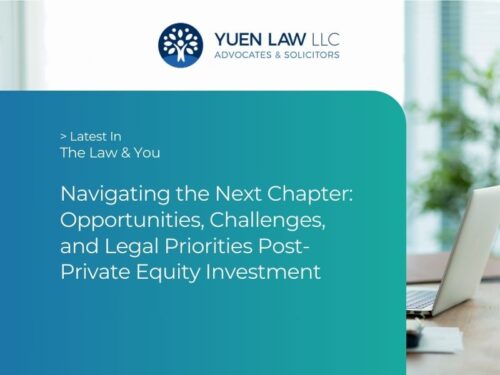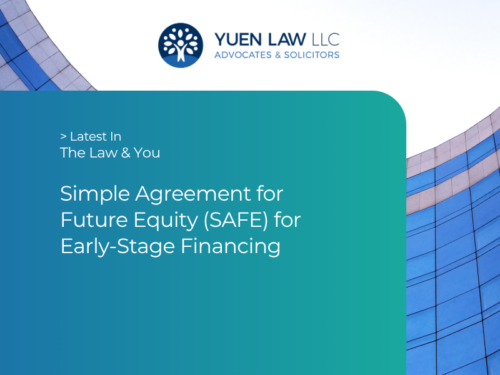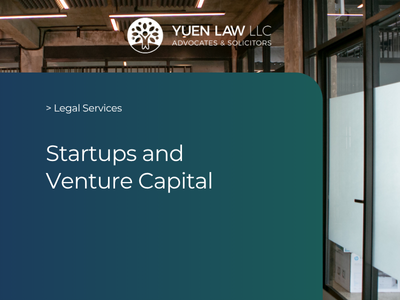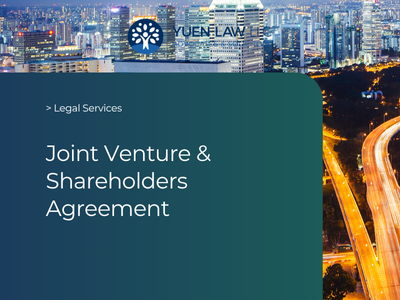Running an entrepreneurial venture in Singapore involves navigating a range of legal requirements essential for success and compliance. One critical aspect that new business owners often overlook is the shareholders’ agreement. This crucial document defines the relationship between shareholders, outlines their rights and responsibilities, and lays the foundation for smooth business operations.
In this article, we will explore why a shareholders’ agreement is vital for the initial parties of startup companies, what it covers, and how it can protect your interests as your business grows.
What is a Shareholders Agreement?
A shareholders’ agreement is a vital legal document for businesses with multiple shareholders. It outlines the rights, responsibilities, and obligations of each shareholder and provides a clear framework for how the company will operate, resolve disputes, and make important decisions. A well-drafted shareholders’ agreement reduces conflicts, promotes smooth governance, and safeguards the interests of all parties involved, viz a viz the company and its shareholders.
Key Highlights
- A shareholders’ agreement defines the relationship between shareholders and the company, establishing their rights and obligations.
- It protects minority shareholders and investors through mechanisms like veto rights and tag-along rights.
- It defines exit strategies, pre-emption rights, and sets rules for governing share transfers.
- While not legally required, a shareholders agreement serves as a valuable playbook for clear decision-making, fairness, and transparency.
Key Roles and Obligations of Each Party
A shareholders’ agreement defines the specific roles and obligations of each party involved in the company. Typically, these roles include:
-
Majority Shareholders: Often responsible for leading decision-making and overseeing day-to-day operations. They may also have the power to approve significant business decisions, such as mergers or capital raises.
-
Minority Shareholders: While they usually have less control, they are granted certain protections, such as veto rights on critical decisions, rights of first refusal, and access to financial information.
-
Directors: Appointed by shareholders to manage the company’s affairs, making strategic decisions, and ensuring the business complies with applicable laws and regulations.
-
Investors: In some cases, investors may have special rights, such as the right to appoint directors, participate in future funding rounds, or receive priority in dividend distribution.
Establishing each party’s rights and obligations helps set clear expectations.
Common Clauses in Shareholders Agreement?
A comprehensive shareholders’ agreement is an essential document that governs various aspects of a company’s operations and its relationship with shareholders. The key components typically include:

| Common Clauses in a Shareholders Agreement | Description |
|---|---|
Shareholding of the Company and Capitalisation Table |
The agreement outlines the number of shares held by each shareholder and includes a capitalization table, showing the percentage of ownership, capital invested, and whether shares are ordinary (with voting rights) or preference (without voting rights), and the issuance date |
Board Composition and Management Arrangements |
This section details how the company will be managed, including the composition of the board, the rights to appoint or remove directors, and voting rights of shareholders. It also clarifies the decision-making process and outlines what happens in the event of a decision deadlock. In some cases, the chairman may have a casting vote to break ties. |
Business Activities and Objectives |
The agreement defines the company’s core business activities and long-term goals. This ensures that all shareholders are aligned with the company’s vision. |
Pre-emptive Rights & First Rights of Refusal |
Shareholders agreements often include provisions to control the transfer of shares. Pre-emption rights allow existing shareholders the rights to buy new shares before third parties. First rights of refusal allow shareholders to buy shares from fellow shareholders before those shares are offered to third parties. This gives shareholders some control over who may join the company as future shareholders, offering safeguards for minority positions. These mechanisms help maintain control of the company and ensure shares stay within the group of existing shareholders and prevents unintended dilution. The agreement may also include mandatory share transfer clauses in certain situations, such as a shareholder’s death or bankruptcy. Additionally, it will outline how shares will be valued to ensure fair transactions. |
Key Man Insurance |
Another common provision in a shareholders agreement is key man insurance, included to ensure business continuity in case a critical shareholder or executive passes away or becomes incapacitated. The agreement specifies the management of the insurance and who benefits from the policy, and the treatment of his shares. |
Rights Issue and Financing |
This section outlines how the company plans to raise capital, whether by issuing new shares or borrowing funds. It includes provisions regarding how future share issuances will be handled, ensuring shareholders understand their rights to subscribe for additional shares. This may involve pre-determined discounts and may include an anti-dilution provisions to protect key shareholders from a reduction in their ownership percentage if new shares are issued. These provisions ensure fairness and transparency during capital-raising efforts. |
Dividend Policy & Distribution of Profits |
The dividend policy defines how profits will be distributed to shareholders and how much will be reinvested into the business for growth. |
Exit Strategies and Termination Provisions |
This section outlines the methods by which shareholders can exit the company. Common exit mechanisms include tag-along, drag-along, Mexican standoff, Russian roulette, shotgun, and put or call options. “Terms like tag-along rights, drag-along rights, Mexican standoff, Russian roulette, shotgun, and put or call options may sound intriguing, but they are simply structured mechanisms that outline how shareholders can buy or sell shares under specific conditions. Choosing the right mechanism ensures a fair process, where all shareholders have a clear and equitable path to buy or sell shares.” Tag-along provisions are particular beneficial for minority shareholders, in the event a third party offers to buy the shares of a majority shareholder, the majority shareholder is not allowed to sell unless the same offer is extended to the minority shareholders. This allows the minority shareholders to “tag-along” on identical terms. It is also common for the shareholders agreement to specify a valuation method in the event of a share sale. |
Restrictive Covenants |
Restrictive covenants in a shareholders’ agreement are provisions designed to protect the business from potential harm caused by shareholders who may compete with the company after they exit. These covenants typically include non-compete clauses and confidentiality clauses, which prevent shareholders from engaging in or starting a competing business for a specified period and within a defined geographic area after leaving the company. If necessary, these clauses may extend beyond the termination of the agreement to safeguard the company’s interests even after a shareholder exits. The duration and scope of these restrictions should be reasonable to balance the protection of the business with the individual shareholder’s right to pursue other opportunities. These provisions help maintain the company’s competitive edge and protect its confidential information, trade secrets, and goodwill. |
Advantages of Shareholders Agreement
A well-crafted shareholders agreement offers several key advantages:
Private Document
Unlike the company’s constitution, which is publicly accessible, the shareholders’ agreement is a private document. This allows you to keep sensitive commercial terms confidential, protecting your business from competitors or other parties whom you do not wish to disclose such information.
Clarity
A shareholders’ agreement clearly defines the rights, obligations, and expectations of each shareholder, reducing the risk of misrepresentation and ensuring everyone operates with a shared understanding.
Management Control
The agreement helps retain control within the management, preventing interference from investors in day-to-day business operations.
Protection of Minority Shareholders
By incorporating provisions like reserved matters and pre-emptive rights, the agreement ensures that minority shareholders are not disadvantaged, while granting them limited control over key business operations. Reserved matters require unanimous approval for significant decisions, giving minority shareholders a voice in major company changes, such as mergers or capital expenditures. It also ensures transparency by granting minority shareholders access to important company information.
Dispute Resolution & Exit Strategies
A shareholders’ agreement can outline specific methods for resolving disputes, such as mediation or arbitration. These approaches are often faster, more cost-effective, and, in the case of arbitration, private—ensuring the outcome remains confidential. If shareholders decide they no longer wish to work together, the agreement also provides clear procedures and options for an orderly exit, allowing for a smooth and transparent departure process.
Private Agreement
Unlike the company’s constitution, which is a public document, a shareholders agreement is a private contract, offering confidentiality and addressing matters not covered by the constitution.

Limits of a Shareholders Agreement
While a shareholder’s agreement is an essential tool for managing shareholder relationships, it does have certain limitations:
Binding Only on Signatories
The agreement is legally binding only on the parties who sign it. If new shareholders join, they must agree to the terms by signing a deed of accession. This ensures that all shareholders, even those added later, are bound by the same agreement.
Enforcement and Legal Recourse
While the terms of a shareholders agreement can be enforced through legal action in the event of a dispute, the process may be time-consuming and costly. Ensuring that the terms are clear, precise, and legally enforceable is crucial to avoid complications during enforcement.
When is the Best Time to Draft a Shareholders Agreement?
Samuel’s nugget of wisdom:
Like my insurance guy always says — the best time to buy insurance is when you don’t need it. Same goes for shareholders’ agreements. The best time to get one done is when everyone’s still friends and full of hope for the venture. That’s when you’re most likely to have open, honest conversations and put the right safeguards in place before things get complicated.
The ideal time to draft a shareholders agreement is before the company is officially incorporated or during its early stages. At this point, shareholders are more likely to have aligned interests, and the company’s operations can be governed by a mutually agreed framework. Waiting until a dispute arises may make it harder to reach a fair agreement.
Conclusion
A shareholder’s agreement is essential for companies with multiple shareholders, providing protection, clarity, and governance. Whether you’re starting a new company or formalizing existing shareholder relationships, drafting a comprehensive shareholders agreement early can mitigate risks and ensure alignment.
Setting the Terms for Success with a Well-Crafted Shareholders’ Agreement
While engaging a lawyer for your shareholders’ agreement isn’t mandatory, the benefits are substantial. Our corporate lawyers ensure that complex clauses are drafted with clarity and that you fully understand the terms. Whether you are a minority or majority shareholder. We identify potential risks and provide strategies to mitigate them before they escalate into disputes.
Drawing on years of experience, we’ve encountered a wide range of shareholder conflicts and know the remedies and safeguards that work best. Clients often ask us what terms are standard in the market—our deep deal experience enables us to provide this insight and help you negotiate confidently. We aim to craft agreements that protect your interests and establish a strong foundation for your business’s growth and governance.
Frequently Asked Questions
What is the difference between a shareholders agreement and company’s constitution?
A shareholders’ agreement is a private contract between shareholders that outlines their rights, responsibilities, and how they will manage their relationship and the company. A company’s constitution is a public document that sets the company’s rules and governance, binding the company, its directors, and shareholders.
Both are needed because the constitution provides the basic legal framework for running the company, while the shareholders’ agreement allows for specific arrangements tailored to the shareholders’ needs, such as decision-making, dispute resolution, buy-outs, and shareholder rights. It also gives shareholders more flexibility and control that the constitution might not address. Having both ensures a clear company structure and addresses the shareholders’ individual interests.
My company already has a constitution; do I still need a shareholders agreement?
Unlike the constitution, which is a public document and easily accessible on ACRA, a shareholders agreement is private document. This allows shareholders to keep the inner workings of their decision-making, governance structures, and other sensitive matters confidential. The private nature of a shareholders agreement ensures that details about share transfers, exit strategies, and internal dispute resolutions remain within the company, protecting business interests and preventing competitors or the public from accessing this strategic information.
How much does a shareholders agreement costs?
The cost of drafting a shareholders agreement varies based on complexity. We offer tailored fixed fee packages to suit your needs. Contact us for a personalized quote based on your business requirements.
We have new shareholders joining our business, do we need to redo or amend my shareholders agreement?
If new shareholders are joining your business and there are no changes to the terms of the existing shareholders agreement, the incoming shareholders can simply sign a deed of accession. This legally binds the incoming shareholders to the same terms as the current shareholders, without needing to redo the entire agreement.
However, if early shareholders have preferential rights that are not extended to new shareholders, the shareholders’ agreement may need to be amended to reflect these differences. This is common in later rounds of investment where new terms or rights are introduced.
What happens if a shareholder breaches the agreement? How do I enforce the shareholders agreement?
If a shareholder breaches the agreement, they may face legal consequences, typically in the form of damages for breach of contract. In some cases, the court may issue an injunction to enforce the terms of the agreement, such as requiring the shareholder to vote or act in accordance with the agreement.
Additionally, shareholders’ agreements often include buy-out provisions, which may require the breaching party to sell their shares to the non-breaching parties or buy out the non-breaching parties’ shares at pre-agreed prices.
What if a shareholder wants to exit the company?
If a shareholder wants to exit the company, they can typically sell their shares to another party or back to the company, depending on the company’s constitution and any shareholder agreements in place.
Is a shareholder's liability limited to their equity contributions to the company?
Yes, in a company limited by shares, a member’s liability is typically limited to the amount they have paid for their shares. However, the Singapore Courts may “lift the corporate veil” and hold members personally liable if the company’s structure is being misused.
Additionally, a shareholder may be personally liable if they have provided a personal guarantee for any of the company’s loans or facilities.







